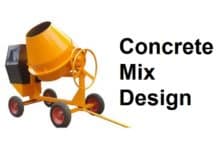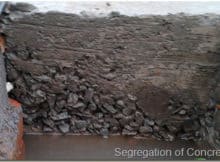Pumping Of Concrete
With the world constantly updating and moving towards efficiency, it is important to understand the challenges associated with using concrete pumps. This article discusses different types of concrete pumps used in construction.
What Is Concrete Pumping Or Pumped Concrete?
Concrete pumps are machines used to transport the freshly mixed concrete mass to the place of pouring. Before concrete pumps were invented, the concreting of tall structures was done by placing the concrete on hoppers and carrying them using cranes. This is not only ineffective but also uneconomical and deliberate.
With the help of the concrete pumps, big projects and mass constructions can be completed effortlessly. Various types of pumps are available in the industry. It is important to identify the most suitable type for the given project. The types of concrete pumps are discussed below in this article.

Advantages Of Concrete Pumping:
- As concrete is poured using concrete pumps, it is faster than manual concreting. It Saves lots of time. Large projects can be completed within very short time.
- Concrete can be sent to far locations and greater heights.
- Concrete can be placed in day and night even in bad weather condition.
- It reduces labour costs and site congestion as it requires less construction workers.
- Concrete is poured freshly before it sets and lose its plasticity improving concrete strength.
- Concreting can easily be done in difficult and inaccessible places like tunnels.
- No wastage of concrete at site.
- Faster transportation of concrete from the source to the pouring point.
- It is effective and economical for residential as well as large sized commercial projects.
Disadvantages Of Concrete Pumping:
- It is uneconomical for projects with concrete volume lesser than 1000 cu.m
- There is a risk of formation of blocks in the pumps.
- The pumps need to be lubricated using a rich mix of mortar before using it.
- The cleaning process that follows the pumping operation is tedious.
- The delivery hoses/pipes should be laid out in such a way there are less bends in them. The layout of the hose has to be constantly monitored for any changes due to the pressure changes within the pipe.
Types Of Concrete Pumps:
The concrete pumps can be classified based on two criteria:
1. Type of placing of concrete.
2. Type of pumping mechanism.
Classification based on type of placing of concrete:
Based on the type of placing of the concrete the pumps can be classified into
1. Boom pumps
2. Line pumps
This classification is important to understand the type of service that will be provided by the given pumps.
1. Boom Pumps:
Boom pumps are the type of pumps mostly used for inaccessible areas. They have special delivery arms that can be remotely controlled by an operator.
There is only very less need for a worker to assist the placing of concrete. These pumps have robotic arms that can be moved with precision and can be used at greater heights.

Advantages Of Boom Pumps:
- They can be used for tall buildings as they can pump for larger heights.
- These types of pumps are superlative for large constructions for placing more concrete in less amount of time.
- These pumps can be made mobile by mounting them on trucks.
- These pumps can be mounted to a heavy surface to increase the capacity of the pump.
- Since they can be automatically poured, the labour cost is minimised. Overhead cost is saved.
- Inaccessible areas can be reached effortlessly.
- Complicated concreting for tunnels can be done easily.
Disadvantages Of Boom Pumps:
- It is uneconomical for large projects.
- Skilled operators are required for operating the pump.
2. Line Pump:
Line pump is also called as trailer pump or stationary pump. The line pump is a type of pump in a trailer to which hoses or pipes are attached.
Any number of hoses can be attached to meet the length requirements. This type of pumping requires a worker to hold the hose or delivery pipe during placing of the concrete.

Advantages Of Line Pumps:
- It is ideal for small projects like concreting for sidewalks, small houses etc.,
- It does not require skilled labours.
- Since it is used in small projects, the lubrication and cleaning required is less.
- They can be mounted on trucks or on any heavy basement.
Disadvantages Of Line Pumps:
- It cannot be used for inaccessible areas.
- Needs constant supervision.
- It cannot be used for large projects.
Though pumping of concrete provides solutions for many problems, there are also special considerations that should be taken into account when opting for pumped concrete.
Classification Based On Type Of Pumping Mechanism:
Based on the mechanism used, concrete pumps can be divided into
1. Piston type concrete pumps
2. Squeeze type / peristaltic concrete pumps
It is important to understand what type of pump mechanism is used to assess the capacity of the pumps.
1. Piston Type Concrete Pumps:
This pump consists of a delivery hopper where the well mixed concrete of sufficient slump is placed. The pump has a piston that helps in pumping the concrete that was placed in the delivery hopper. This pump has two valves each performing in coherence with each other.
This pump works on two stroke principle – the suction stroke and the delivery stroke. During the suction stroke, the inlet valve is opened and the outlet valve is closed. The concrete placed on the delivery hopper is allowed to fall into the pump due to gravity.
During the delivery stroke, the inlet valve is closed and the outlet valve is opened. The piston pushes the concrete through the outlet valve. This is followed by the suction stroke and then so on till the process is completed.
Rubber cups are provided in the piston to ensure that the pressure is not released. This type of pump can be reassembled easily and checked for failure at any given point of time.
Advantages:
- This mechanism can pump concrete through a distance of 1000 m horizontally and 120 m vertically.
- It can pump as much as 130 cu.m of concrete per hour through an 8-inch pipe.
- It is very helpful in large projects where large volumes of concrete are to be pumped.
- The setup of the pump allows itself to be repaired easily during any blockage or formation of concrete plugs.
Disadvantages:
- It is not economical for small projects.
2. Squeeze Type / Peristaltic Type Pumps:
In this type of pump, the concrete of sufficient slump is placed inside the delivery hopper. The delivery hopper has rotating blades that are continuously assisting by pushing the concrete into the pumping chamber. Inside the pumping chamber a vacuum pressure of 60 cm Mercury is maintained.
There are two rollers connected to a planetary drive that is constantly forcing the concrete through the delivery hose. Due to the high vacuum, the concrete is continuously pumped out through the delivery hose. This type of pump is mostly attached to a truck and can be mobile.
Advantages:
- It is ideal for small projects
- It can pump 20 cu. m of concrete in one hour in a 3-inch pipe.
- It can pump concrete to 90 m horizontally and 30 m vertically.
- Since it is used in small projects, the lubrication and cleaning required is less.
Disadvantages:
- This pump is not ideal for large projects.
Challenges Associated With Concrete Pumping:
1. The slump of the concrete should be within 50 mm to 100 mm. A slump of below 50 mm will be impossible and impractical to pump. A slump greater than 100 mm will increase the risk of segregation of the aggregates and will most likely cause blocking.
2. The maximum size of crushed aggregate should be 1/3rd the diameter of the hose or delivery pipe. For rounded aggregates (uncrushed aggregates) the maximum size is limited to 40% of the diameter of the hose or delivery pipe.
3. The more crushed the aggregate is, the more is the surface area of the aggregate. More surface area requires high amount of cement paste to increase the flowability.
4. Before the pumping operation is started, the pipe has to be lubricated properly. It is done in stages by allowing a mortar mix to pass slowly through the pipe for the whole length and then repeated with a higher speed.
5. After the pumping has commenced, it is desirable to not stop the pumping action. This causes unnecessary blocking in the concrete due to the formation of concrete plugs.
6. The delivery hopper of the concrete should be constantly checked for materials. If the concrete in the delivery hopper is not refilled properly, it may lead to the disruption in the pumping process.
7. The concrete pumps should be placed as close as possible to the site of interest.
8. Bends in the pipes should be avoided. They are vulnerable to blockage. Bends also demand high power input for the pumps.
9. If the concrete is pumped below, a pressure release valve has to be provided at the top to release the air and to avoid the formation of air bubbles. These air bubbles may affect the strength of the concrete.
10. If the concrete is pumped above, a valve has to provided near the pump to prevent reverse flow of the concrete.
11. Mostly a Cement: Aggregate ratio of 1:6 is taken.
12. The maximum size of aggregate is limited to 20 mm.
13. Water cement ratio of 0.5 to 0.65 is sufficient
14. A concrete mix of 1:2:4 is found to be ideal for pumping the concrete.
15. Well graded aggregates should be used.
16. Check the bearing capacity of the area before setting up a pumping operation. The concerned area should be able to carry loads of trucks and the operating stresses.
Also Read
25 Types Of Concrete Used In Construction
Types Of Pipes Used In Water Supply System
System Of Plumbing In Buildings
Basic Construction Process Of RCC Columns
For More Updates like our Facebook Page and join our Telegram Channel.





Very useful knowledge👍